|
|
|
Sort Order |
|
|
|
Items / Page
|
|
|
|
|
|
|
| Srl | Item |
| 1 |
ID:
048163
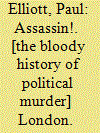

|
|
|
|
|
| Publication |
London, Blandford Book, 1999.
|
| Description |
239p.Hardbound
|
| Standard Number |
0713727594
|
|
|
|
|
|
|
|
|
|
|
|
Copies: C:1/I:0,R:0,Q:0
Circulation
| Accession# | Call# | Current Location | Status | Policy | Location |
| 042552 | 364.1523/ELL 042552 | Main | On Shelf | General | |
|
|
|
|
| 2 |
ID:
083100
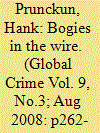

|
|
|
|
|
| Publication |
2008.
|
| Summary/Abstract |
An article that discusses how information and communications technology (computer systems and data transmission) are used as 'cyber weapons' for criminal purposes. It canvasses a number of legislative policy options for controlling their misuse. The paper concludes with the view that implementing some form of cyber weapons laws - in the same vein as firearms legislation - would not only help ensure society's domestic well-being, but would also aid national security.
|
|
|
|
|
|
|
|
|
|
|
|
|
|
|
|
| 3 |
ID:
046292


|
|
|
|
|
| Publication |
Pretoria, Institute for Security Studies, 2002.
|
| Description |
vii, 145p.
|
| Standard Number |
0919913076
|
|
|
|
|
|
|
|
|
|
|
|
Copies: C:1/I:0,R:0,Q:0
Circulation
| Accession# | Call# | Current Location | Status | Policy | Location |
| 046200 | 364.4/PEL 046200 | Main | On Shelf | General | |
|
|
|
|
| 4 |
ID:
138779
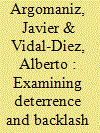

|
|
|
|
|
| Summary/Abstract |
Scholars are increasingly drawing on models and theories from the field of Criminology to offer new insights on terrorist violence. A particularly useful framework by LaFree, Dugan, and Korte works from the assumption that illegal behaviour can be affected by the threat and/or imposition of punishment. It sees the results of the government's intervention in terms of deterrence (state's repressive action leads to a reduction in terrorism violence), and backlash (state's repressive action leads to defiance and retaliation, and to an upsurge of terrorism violence). This article applies this model to a case study of the government's responses to Euzkadi Ta Askatasuna (ETA). It uses a variation of survival analysis technique—Series Hazard—to assess the impact of six major initiatives on the risk of new ETA attacks in the period from 1977 to 2010. Mostly, the results provide support for both backlash interpretations, although important questions regarding interpretation are raised.
|
|
|
|
|
|
|
|
|
|
|
|
|
|
|
|
| 5 |
ID:
125362
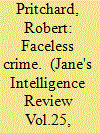

|
|
|
|
|
| Publication |
2013.
|
| Summary/Abstract |
As awareness of the need for online privacy grows, technology is increasingly becoming available to help internet users maintain anonymity, Robert Pritchard investigates illegal activities facilitated by such technology and the inherent problems in tacking it.
|
|
|
|
|
|
|
|
|
|
|
|
|
|
|
|
| 6 |
ID:
077388
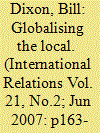

|
|
|
|
|
| Publication |
2007.
|
| Summary/Abstract |
A framework for analysing policy transfer developed by David Dolowitz and David Marsh has begun to attract the attention of criminologists interested in understanding how crime policies travel. This article uses this framework to assist in tracing the genealogy of a style of local, geographically responsible `sector' policing which is currently being implemented by the South African Police Service. After locating sector policing as a distinctive approach within the broader tradition of community policing, the article considers the origins and development of geographically responsible policing in Great Britain and the United States before focusing on its adoption and adaptation in post-apartheid South Africa. Answers to the seven questions suggested by Dolowitz and Marsh's framework are then sought in an effort to understand more fully the genealogy of sector policing in South Africa and the role of international policy transfer in it.
|
|
|
|
|
|
|
|
|
|
|
|
|
|
|
|
| 7 |
ID:
158632
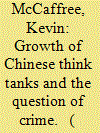

|
|
|
|
|
| Summary/Abstract |
This paper reviews several of the key issues that underlie the development and expansion of think tanks in China from both a domestic and international perspective. Substantively, the review focuses on the need to develop criminological think tanks in China due to the well-documented relationship between rapid urbanization, social displacement, and crime. Though work on urbanization, social disorganization, and crime has existed for over half a decade in Western criminology, it suffers from a lack of research outside of the Western and usually more specifically American, cultural context. To advance this call for research, the paper identifies 14 generative research programs in the areas of the Routine Activities Theory, Social Bonds Theory, and Institutional Anomie Theory pursuable by Chinese criminological think tanks. The paper concludes with a brief discussion of some potential barriers to the successful production and dissemination of criminological research in China.
|
|
|
|
|
|
|
|
|
|
|
|
|
|
|
|
| 8 |
ID:
132305


|
|
|
|
|
| Publication |
2014.
|
| Summary/Abstract |
This note describes a new and unique, open source, relational database called the United States Extremist Crime Database (ECDB). We first explain how the ECDB was created and outline its distinguishing features in terms of inclusion criteria and assessment of ideological commitment. Second, the article discusses issues related to the evaluation of the ECDB, such as reliability and selectivity. Third, descriptive results are provided to illustrate the contributions that the ECDB can make to research on terrorism and criminology.
|
|
|
|
|
|
|
|
|
|
|
|
|
|
|
|
| 9 |
ID:
109141


|
|
|
|
|
| Publication |
2011.
|
| Summary/Abstract |
My aim in this article is to extend Marc Sageman's seminal research on Al Qaeda by re-articulating it through the prism of Albert Cohen's theory of delinquent subcultures, an approach which came to prominence in Criminology in the 1960s, but has since then been largely eclipsed by other approaches in that field. Drawing on Sageman's findings and observations, I suggest that Al Qaeda-affiliated or -inspired groups in the West can be best understood as a collective response or "solution" to the strains encountered by the members of these groups, and that these strains are imposed on them by the circumstances in which they find themselves. My broader aim is to show that although Criminology, with a few exceptions, ignores the subject of terrorism, terrorism studies can appreciably benefit from an engagement with Criminology as a source of theoretical inspiration.
|
|
|
|
|
|
|
|
|
|
|
|
|
|
|
|
| 10 |
ID:
138778


|
|
|
|
|
| Summary/Abstract |
Despite several overlaps between crime and terrorism, criminological examinations of terrorism to date have been limited. To fill this gap in the research, we examine several individual and contextual socio-demographic characteristics of a diverse sample of extremists operating in the United States who have committed violent crimes. In addition, we provide a comparative analysis to explain and understand differences between extremists who have committed violent crimes while active in either far-Right, far-Left (including environmental and animal rights extremists), or Al Qaeda and affiliated movements. To assess the impact of external factors on the nature of domestic extremist violence, we also comparatively examine these three types of domestic extremists before and after the September 11, 2001 terrorist attacks. We find several similarities across domestic extremists but many important suspect- and county-level differences as well. We end the paper with suggestions for future research that could extend the criminological study of terrorism.
|
|
|
|
|
|
|
|
|
|
|
|
|
|
|
|
| 11 |
ID:
189271


|
|
|
|
|
| Summary/Abstract |
The question of how to deter sub-conventional activities—characterized by a limited role for the use of force—is one of the biggest puzzles in security studies. A way forward might be to use an enduring rivalry conflict management framework and to focus on findings from criminology. As the case study of 56 Estonian airspace violations suggests, executing sub-conventional deterrence is not an easy task to achieve. NATO’s deterrence success remains elusive, because there is no consistency in responding to these violations and no meaningful punishment. Yet many changes in frequency, intensity, and volatility of Russian intrusions over the last two decades indicate that a successful dissuasion, if not de-escalation, is still possible. To achieve that, NATO needs to improve information transmission, define its deterrence goals more narrowly, impose group-level costs, and implement dynamic deterrence mechanisms offering alternative modes of behavior.
|
|
|
|
|
|
|
|
|
|
|
|
|
|
|
|
| 12 |
ID:
090281


|
|
|
|
|
| Publication |
2008.
|
| Summary/Abstract |
As a scholarly discipline, criminology in China is growing in stature, maturity and utility. In the short thirty years since 1979, China has successfully established criminology as a scientific field of study with well-defined subjects, recognised scholars and copious research/publications. A cursory review of pertinent literature in law, criminology and China studies shows that to date, there are very few systematic and comprehensive studies of criminology (in English language) as an emerging and important field of academic discipline in China. As a result, we know very little about its focus and scope; direction and trend; theories and findings; and problems and issues. This is a first attempt to do so. The article (in two parts, published separately) investigates into: 'Literature on law, crime and punishment in China'; 'The idea of crime (Fanzui)'; 'Traditional thinking of crime and punishment in imperial China'; 'Nature and structure of criminology as a discipline'; 'Contemporary development of criminology in China'; 'Contemporary theories on crime and punishment' and 'Fundamental issues and challenges' facing criminological research in China.
|
|
|
|
|
|
|
|
|
|
|
|
|
|
|
|
| 13 |
ID:
092022


|
|
|
|
|
| Publication |
2009.
|
| Summary/Abstract |
As a scholarly discipline, criminology in China is growing in stature, maturity and utility. In the short thirty years since 1979, China has successfully established criminology as a scientific field of study with well-defined subjects, recognised scholars and copious research/publications. To date, there are very few systematic and comprehensive studies of criminology (in English language) as an emerging and important field of academic discipline in China. As a result, we know very little about its focus and scope; direction and trend; theories and findings; and problems and issues. This is a first attempt to do so. The article (in two parts, published separately) investigates into: 'Literature on law, crime and punishment in China', 'The idea of crime (Fanzui)', 'Traditional thinking of crime and punishment in imperial China', 'Nature, structure and development of criminology', 'Contemporary theories on crime and punishment' and 'Fundamental issues and challenges' facing criminological research in China.
|
|
|
|
|
|
|
|
|
|
|
|
|
|
|
|
| 14 |
ID:
189337


|
|
|
|
|
| Summary/Abstract |
Deterrence by denial is gaining attention as a counter-terrorism strategy. Yet there are formidable obstacles to testing its empirical validity. We argue that experimental and quasi-experimental evidence from criminology offers support for deterrence by denial strategies. Studies of individual offending, gangs, and mafias suggest that deterrence by denial would not displace terrorist activity elsewhere. We also find evidence that physical target hardening and enhanced human guardianship can deter terrorism, with public surveillance being less effective. Criminological evidence thus supports that deterrence by denial works by increasing the risk of failure. We argue for further rapprochement between terrorism and related research fields.
|
|
|
|
|
|
|
|
|
|
|
|
|
|
|
|
| 15 |
ID:
157824
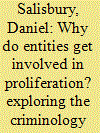

|
|
|
|
|
| Summary/Abstract |
This article seeks to provide an original approach to weapons of mass destruction (WMD)-related illicit trade by drawing on criminology and focusing on the transactional level. Specifically, the article discusses the “rational-choice” model as a way to understand an entity’s involvement in illicit trade, and considers also the limitations of this approach, as well as the role that opportunity plays in an actor’s decision to engage in illicit trade. The article draws the conclusion that the prospects of deterring illicit trade using export controls and related criminal sanctions are limited. Beyond the clear limitations of the rational-choice model, the prospects of deterring illicit WMD trade are limited by the low levels of certainty in export-control enforcement, something that the criminology literature suggests is of greater importance than severity of punishment in deterring crime. Nonproliferation successes are more likely to be found in further efforts to develop tools to address proliferation opportunities, an area that has already seen much work. Efforts to further raise illicit WMD-related trade from the realms of “invisible crime” are necessary, including further conceptual research on illicit trade.
|
|
|
|
|
|
|
|
|
|
|
|
|
|
|
|
|
|
|
|
|